TEN YEARS AGO TODAY! COMPLETE TEST OF THE 2011 KTM 350SXF
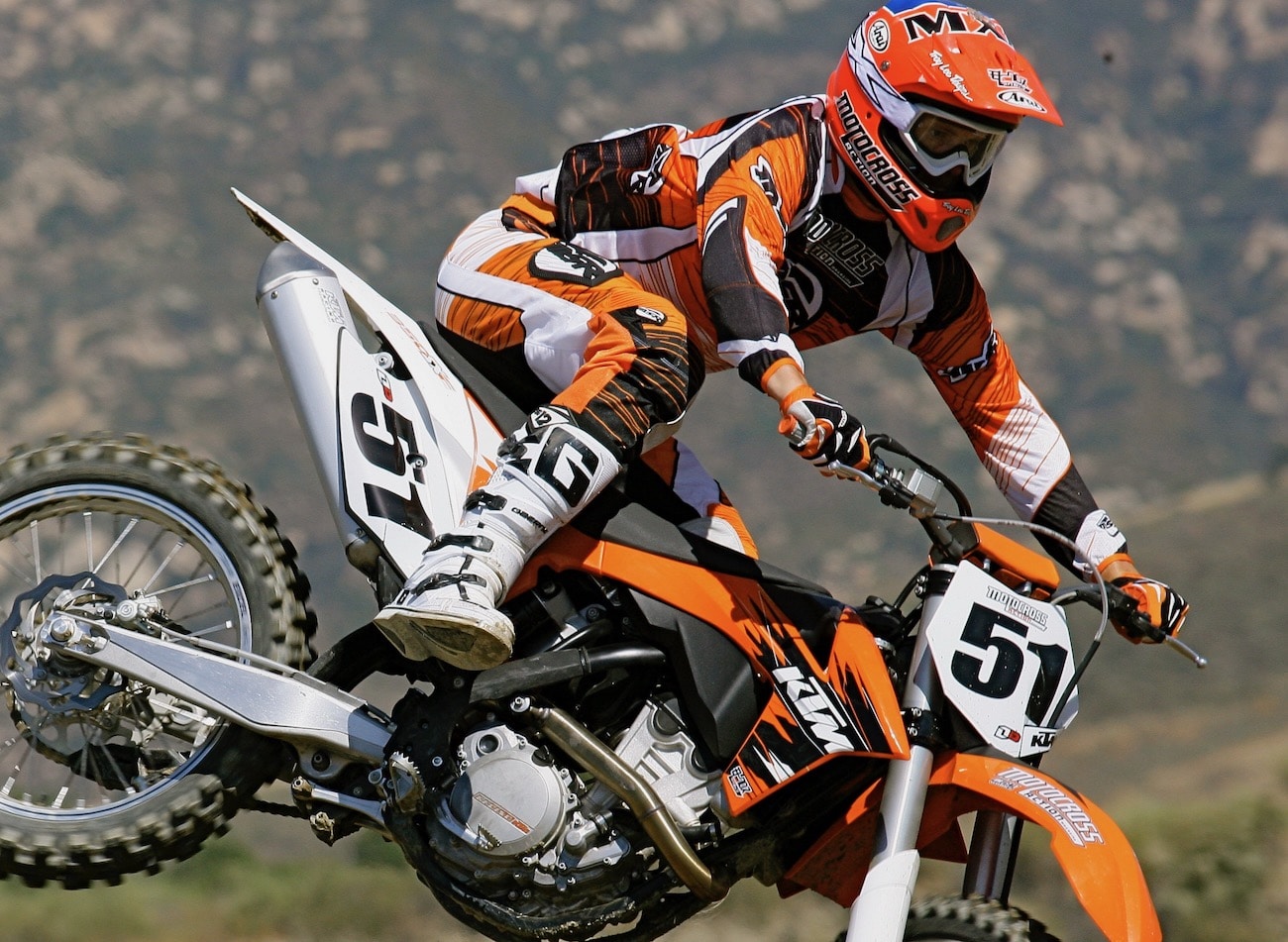
This 2011 KTM 350SXF test is from the September 2010 issues of MXA.
Q: FIRST AND FOREMOST, IS THE 2011 KTM 350SXF GOING TO CHANGE THE MOTOCROSS WORLD?
A: No. In truth, the 2011 KTM 350SXF is just another piece of the matrix of motocross. It is not going to wipe the 450cc motocross bike off the face of the Earth. It is not going to bring in a new era of mid-size engines. It is not a revolutionary idea (and if it is, then several other motocross manufacturers got there first, including, but not limited to, Husqvarna, ATK and the original Yamaha YZ400). It is essentially a niche motorcycle that fills a void. The KTM 350SXF is an interesting exercise, but if you think it will replace the 450cc motocross bike you are mistaken.
Q: WHO IS THE MOST LIKELY KTM 350SXF BUYER?
A: Given the way that the KTM 350SXF demands to be ridden, which we will get to in detail in a minute, it is not a plug-and-play replacement for a 450cc motocross bike. The 350SXF and its sibling, the 450SXF, are night-and-day different, which is surprising when they share so many components. If push came to shove, we’d say that there are three main buyers for the 2011 KTM 350SXF:
(1) Vet riders: For a Vet class rider who would prefer to race a 250cc bike, but can’t afford to give up 20 horsepower to his 450-equipped competition, the 350SXF offers all the charms of a very fast 250, with the torque curve of a slow 450. Although there are spots on the dyno curve where it gives up as much a 11 horsepower to the 450SXF.
(2) Play riders: When you aren’t bound by any rules, and are just looking for a fun bike to ride, the 350SXF is a little bit like owning a 450 at low rpm and a 250 at high rpm.
(3) 250 transplants: For a kid coming straight out of the 250 class for the 450 class, the 350SXF offers the familiarity of a high rpm, pin it to win it, flat-out 250 four-stroke—without the arm-stretching blast and bulk of a 450.
Q: IS THE 350SXF A BIG-BORE 250 OR A SLEEVED-DOWN 450?
A: Neither. The 60-pound, five-speed, DOHC, finger follower, four-valve, 349.7cc engine shares the design concept of the 250SXF in terms of weight, compactness and design, but none of the parts.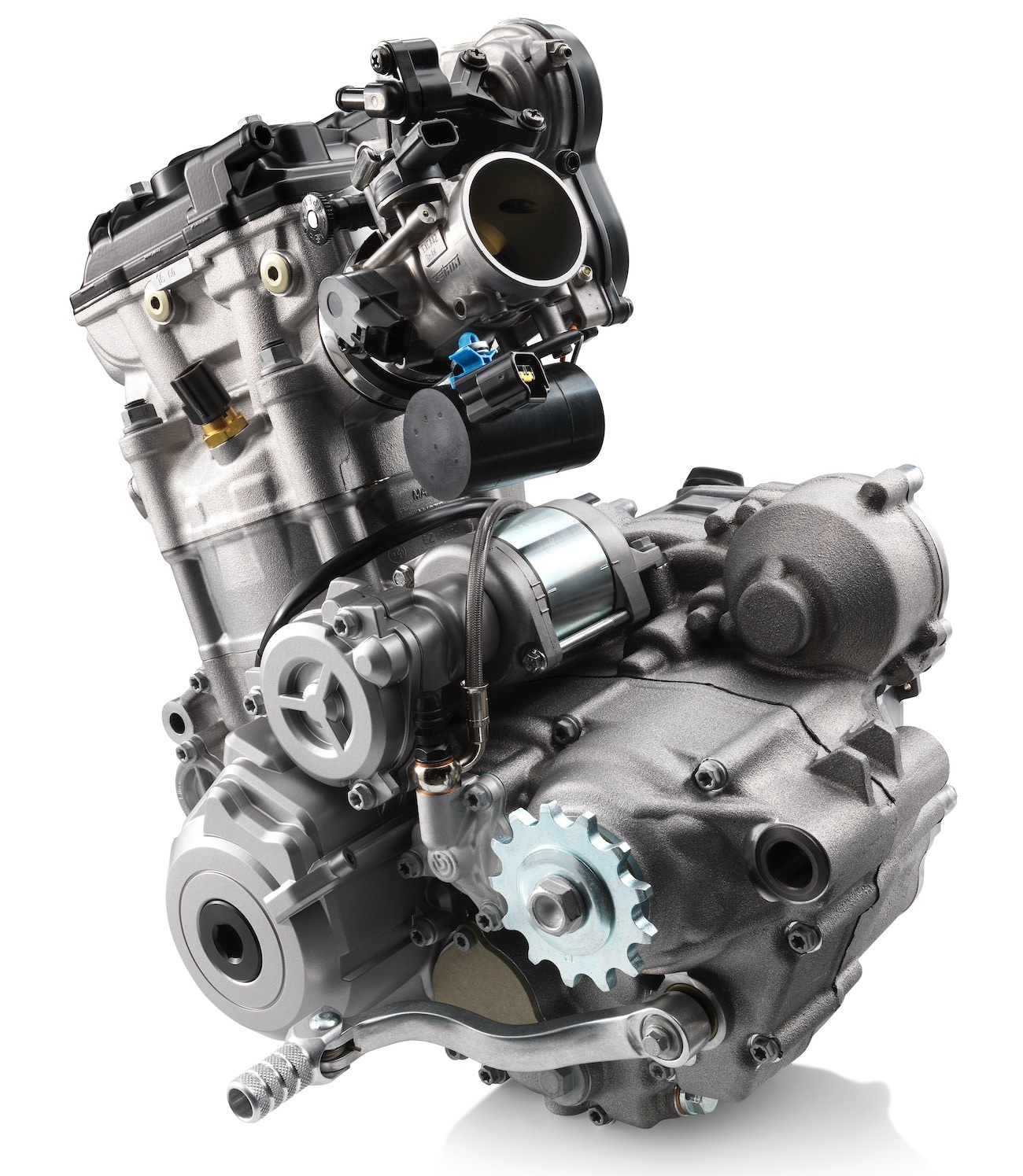 The fuel-injected, electric start, KTM 350SXF engine shares very few parts with its brothers.
The fuel-injected, electric start, KTM 350SXF engine shares very few parts with its brothers.
Q: WHAT IS THE BORE AND STROKE OF THE 250SXF, 350SXF AND 450SXF?
A: The 250SXF bore and stroke is 76mm x 54.8mm, the 350SXF is 88mm x 57.5mm and the 450SXF is 97mm x 60.8mm. The compression ratio on the 350SXF is 13.5:1.
Q: WHAT IS THE HEAD ANGLE OF THE 250SXF, 350SXF AND 450SXF?
A: All three bikes have the same 26.5-degree head angle.
Q: WHAT IS THE SUGGESTED RETAIL PRICE OF THE2011 250SXF, 350SXF AND 450SXF?
A: The 2011 250SXF retails for $7699, the 350SXF goes for $8499 and the 450SXF sells for $8799.
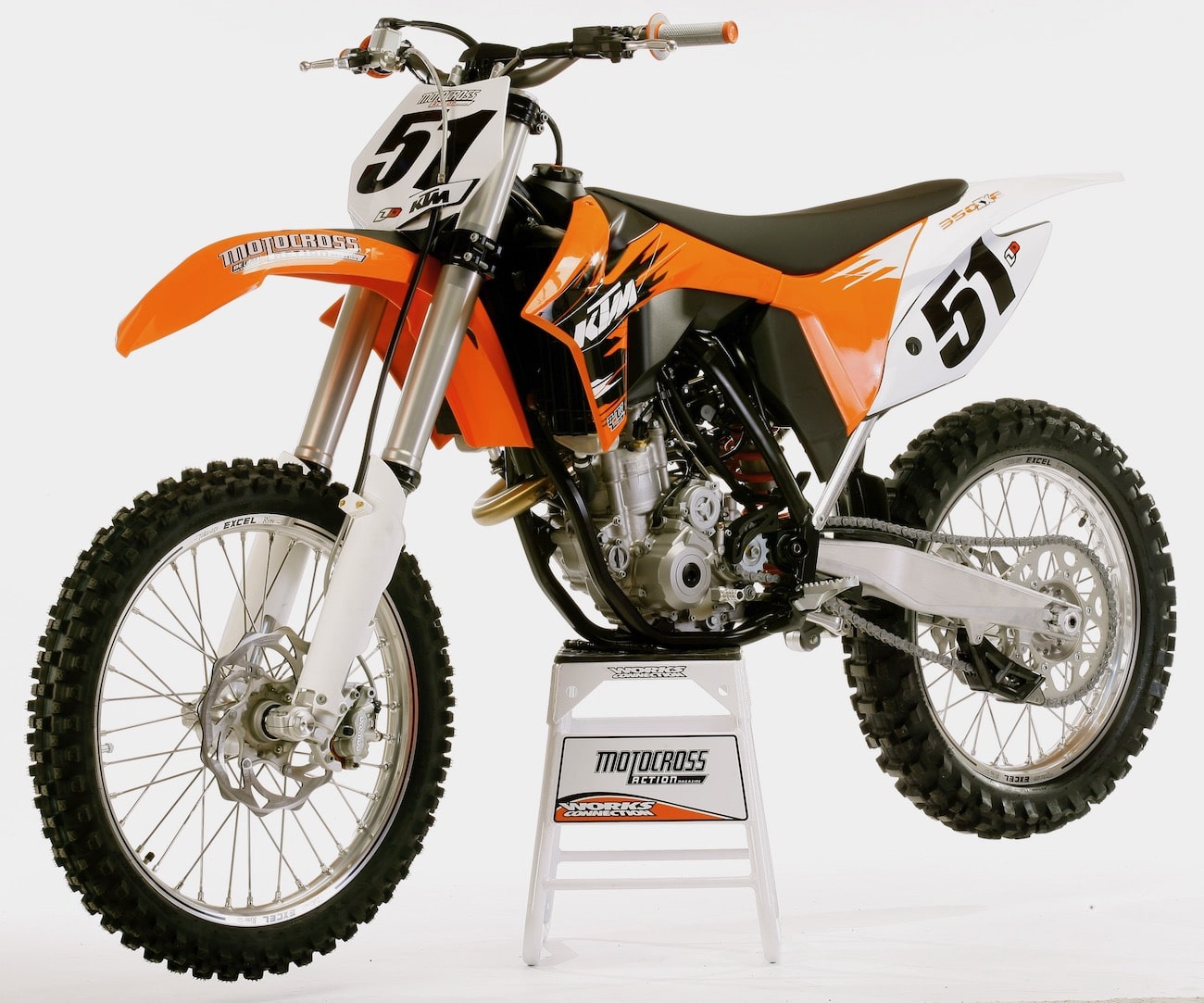 2011 KTM 350SXF: KTM has always made bikes to fill niches. The 350SXF follows in the footsteps of the 150SX, 200XC and 300XC. It hits the Japanese brands where they ain’t.
2011 KTM 350SXF: KTM has always made bikes to fill niches. The 350SXF follows in the footsteps of the 150SX, 200XC and 300XC. It hits the Japanese brands where they ain’t.
Q: IS THE 2011 350SXF FASTER THAN THE 2011 450SXF?
A: No. Not even close. That isn’t to say that you couldn’t go faster on the 350SXF than you could on the 450SXF, but when the moments are frozen and pure performance is all that is measured, the 350SXF engine can’t hold a candle to the 450SXF engine.
Q: HOW MUCH HORSEPOWER DOES THE 350SXF MAKE ON THE DYNO
A: The 350SXF makes a respectable 46.94 horsepower at a very high 12,200 rpm.
Q: HOW DOES THE HORSEPOWER OF THE 350SXF COMPARE TO THE 250SXF AND 450SXF?
A: You don’t need to wear a deerstalker hat and smoke a pipe to figure out the answer to this question. It is elementary, my dear Watson. The 250SXF makes 38.25 horsepower, the 350SXF makes 46.94 horsepower and the 450SXF makes 53.92 horsepower. Rounded off, there is an 8 horsepower difference from the 250 to the 350 and from the 350 to the 450 (the 8 is a median number, in truth the gaps are larger above and below peak).
Q: WHAT CAN WE LEARN FROM THE DYNO RUNS OF THE 250, 350 AND 450SXF’S?
A: First and foremost, if you aren’t bound by a class structure (if you are a Vet racer or a professional practice rider), there is no reason to ever buy a 250cc four-stroke again. Why not? Because the dyno curve, rpm range and revvability of the KTM 350 is identical to that of the KTM 250SXF—only with 6 to 10 horsepower more at every spot along the curve. In essence, the 350 has a 250 power curve, but with a better-than-works 250F powerband.
When it comes to comparing the 350SXF dyno curve to that of the KTM 450SXF, the 450 romps all over the 350 from 5000 rpm to, well, until the cows come home. At no point on the usable 450SXF powerband curve does the 350SXF make more horsepower than the 450. And, the 350SXF’s peak horsepower is at 12,200 rpm, while the 450SXF peaks at a much lower 8200 rpm.
Mathematically, the KTM 350SXF is to the 250SXF what the 450SXF is to the 350SXF. Say what?
Q: HOW GOOD IS THE POWERBAND ON THE MID-SIZE 2011 KTM 350SXF?
A: It’s good and it’s bad. It’s focused and it’s confused. It is, as you would expect from a machine that is trying to meld two worlds, a confused powerband. It is very much a Dr. Jekyll and Mr. Hyde engine (or maybe two Dr. Jekylls without a Mr. Hyde).
The first personality is from low to mid. Off the bottom and into the mid-range, the 350SXF has a nice torquey feel. When it is on the track all by itself it feels like a 450, but it runs very much like a 1998 Yamaha YZ400. Smooth, tractable, pleasant and metered. Not fast, but usable. It feels like a 450, until you ride a 450 at the same rpm range—then it feels like a 350.
The second personality shows itself as the engine climbs into the top end. Unlike a 450, the 350SXF makes all of its serious horsepower above 10,000 rpm. Since it makes its most horsepower as the last rpm is wrung out of the engine at 12,200 rpm, you have to take it to the rev limiter if you want to make the 46.94 horsepower work for you (because at every rpm below max, it makes less and less horsepower). To be successful you have to rev it…really rev it.
Q: WHAT IS THE BEST WAY TO RIDE THE 2011 KTM 350SXF?
A: Flat out. Think of it as a 250 four-stroke and ride it accordingly. Rev it out. Don’t shift until you hit 12-two. Never lug it down on the torque curve (unless you are going to or from the starting line). This bike is not a replacement for a 450cc motocross bike; it is closer to what a works 250 engine feels like (only it isn’t legal in the 250 class).
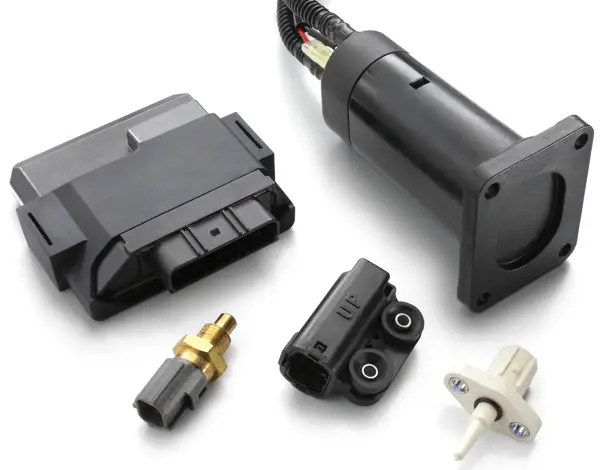
KTM’s fuel pump (upper right) is half the size of the fuel pumps on other EFI bikes.<
Q: CAN YOU REPROGRAM THE IGNITION?
A: Yes. Even better than fiddling with the world of software and laptop computers, there are three maps already programmed into the KTM’s ignition module. The only catch: You need to buy an optional $50 switch to access them. The three maps are aggressive, standard and soft. We used the aggressive map (which we chose because of issues with the stock gear ratios).
Q: WHAT DOES THE 2011 KTM 350SXF REALLY WEIGH?
A: KTM says that the 350SXF weighs 230.2 pounds, but on our scale it weighed 237 pounds (without gas—which is how they are weighed by the FIM and AMA). In a perfect world, the 2011 KTM 350SXF would weigh 220 pounds. Why? Because that is the minimum weight limit for a bike in the 450 AMA National class. Additionally, the inherent philosophy of building a mid-sized 350cc engine is that you can put it in a 250 frame and compensate for the loss of horsepower with a lower overall weight.
Q: WHERE DID THE WEIGHT COME FROM?
A: At 237 pounds, the 350SXF is not light. Why? Let’s assume that the typical 250F weighs 220 pounds. To make it into a 350SXF, you have to add in the beefed-up engine components, steel clutch basket, stronger frame and larger rear tire. That is conservatively about 6 pounds more. Next on the agenda is the fact that fuel-injected bikes typically weigh about 3 pounds more than a carbureted bike because of the electric fuel pump, thicker gas tank and added magnets of the magneto. Finally, KTM elected to mount an electric starter on the 350SXF. And, even though the KTM 350SXF starter motor is slightly smaller than the 450SXF unit, there are still the issues of the battery, starter gear and starter itself. All this weighs about 5 more pounds (because you get to deduct the weight of the kickstarter, kickstarter gear and idler gear). The total weight gain is 14 pounds. When you add 14 pounds to 220 pounds, you get a ballpark figure of 234 pounds. By this calculation, the 2011 KTM 350SXF is about 3 pounds heavier than it should be.
For comparison, the 2011 KTM 450SXF weighs 242 pounds. The 5 extra pounds are attributed to the 450’s larger cases, bigger crank and longer frame rails.
Q: WHAT WERE OUR BEST FORK SETTINGS?
A: We ran the same basic setup that we used on our KTM 450SXF (after all, there’s only a 5-pound weight difference). We dropped the stock 0.48 fork springs, which are way too soft) for the 0.50 springs from the 450SXF and juggled the oil height to suit track conditions. For hardcore racing, we recommend this fork setup on the 2011 KTM 350SXF:
Spring rate: 0.50 kg/mm (0.48 kg/mm stock)
Oil height: 365cc (375 stock)
Compression: 12 clicks out
Rebound: 12 clicks out
Fork leg height: 5mm up (at the first line)
Note: In stock trim the forks hang down and lose a lot of travel. We ran stiffer springs to keep the forks higher and suggest that if you are 175 pounds or more that you do the same thing (then, lower the oil height to iron out the midstroke harshness). Oil height is a simple tuning trick for WP forks. Take 10c out if you think they are too harsh in the middle and add 10cc if your think they are too soft at the end of the stroke.

What would we change? The gearing, oil filler cap, exhaust system, shock spring, ignition mapping, fork springs, preload adjuster, gas cap and radiator vent hose are all on the list.
Q: TO LINK OR NOT TO LINK?
A: The KTM 250/350/450SXF’s come with rising rate linkage, while the KTM 125SX, 150SX and 250SX two-strokes stick with the previous no-link PDS system. It is no secret that KTM did not want to go to Japanese-style rising-rate linkage, but they had no choice. Although their PDS no-link rear suspension had developed into a very good rear suspension system for those who knew how to set it up, public opinion forced the move to linkage.
When the rear wheel moves upward, the rising rate of the shock linkage’s arc forces the shock shaft to move faster (even though the rear wheel is still moving at a constant rate). Guess what? KTM’s no-link PDS system does the same thing. So what is the difference? The main difference is that the new linkage can be fine-tuned by changing the eccentric cam profile to make the shock have more damping at the very end of the stroke. On the other hand, the no-link system is lighter, easier to work on and produces a more linear spring progression. Scientifically, the most notable benefit of the linkage should be felt in the last inch of the shock’s stroke. We didn’t feel it.
Q: WHAT WAS OUR BEST SHOCK SETTING?
A: The rear suspension was harsh, a little choppy and still seemed prone to G’ing out (in spite of the benefits of the rising rate linkage). Our solution was to swap out the stock 5.4 shock spring for the 5.7 spring from the 2011 KTM 450SXF. This held the rear up higher and allowed us to balance out the chassis in coordination with the stiffer fork springs. Perhaps the most noticeable thing about the rear suspension on the 350SXF is that it feels remarkably similar to the no-link rear suspension that came on the KTM four-strokes last year. This should not come as a major surprise, since KTM used the same test riders that developed the no-link to develop the linkage. They know what they like and since they liked the PDS system, they worked with the KTM linkage system until they liked it too. If there is a difference between the linkage bike and the PDS bike it is that the linkage doesn’t seem to extend as far to the extremes in the rough as the PDS system. The rebound feels more contractive, although the compression stroke is identical.
For hardcore racing we recommend this shock setup for the 2011 KTM 350SXF:
Spring rate: 5.7 kg/mm (5.4 kg/mm stock)
Race sag: 100mm
Hi-compression: 2-1/4 turns out
Lo-compression: 15 clicks out
Rebound: 12 clicks out
Notes: Although KTM has often recommended 110mm or more of sag, but we think 100-105mm is better.
Q: HOW DOES THE 2011 KTM 350SXF HANDLE?
A: Every MXA test rider loved the accurate feel of the 350SXF. Once we resolved issues with the fork and shock spring rates, we were able to raise the fork height to select the amount of turn-in we wanted. Once you get the balance right, this bike corners like it’s on rails. We know for a fact that the 2011 Suzuki RM-Z450 turns sharper, but it sacrifices straight line stability for quickness in the tight stuff. The KTM is a better all-around chassis. It turns, but it doesn’t make sacrifices in your name at speed.
The 2011 model is much sleeker, smaller, lower and narrower-feeling at the top (and KTM was smart enough to keep the footpegs far enough apart to offer a firm stance in the rough stuff). KTM went from the bottom of the heap to the top by making small changes every model year. A lot of the credit may well go to the tunability of steel frames when compared to cast or forged aluminum frames.
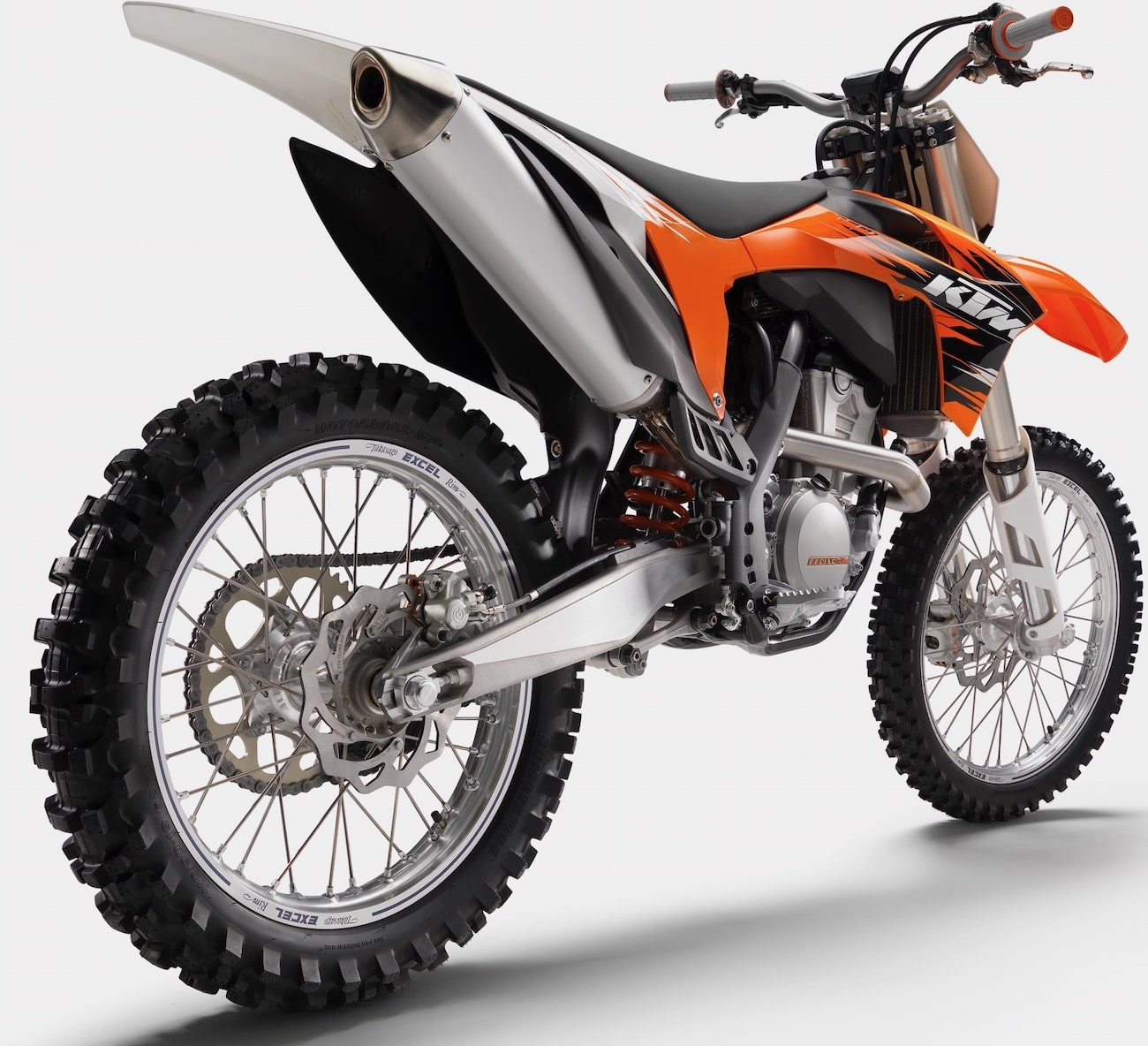 Since the KTM 350SXF is only slightly lighter than the 450SXF and is raced in the same class — we stiffened both ends.
Since the KTM 350SXF is only slightly lighter than the 450SXF and is raced in the same class — we stiffened both ends.
Q: WHAT DID MXA DO TO MAKE THE KTM 350SXF WORK BETTER?
A: Here is the list:
(1) Reprogram. We went from the standard ignition curve to the “aggressive” curve. This is ignition timing only, not fuel mapping. To access the maps you need KTM’s optional adjuster dial ($49.60 from your local dealer).
(2) Gearing. We geared it down one tooth (from 50 to 51), and several MXA test riders chose to gear it down two teeth to 52. The stock gap between gears is too large. With the stock setup, the bike has a hard time making the jump from second to third, and it takes a long straight to get the rpm up to the rev limiter. Gearing it down one tooth helps the second-to-third shift and brings the rev limiter into sight. Gearing it down two teeth makes third gear more usable. The long pull may seem like a good thing, but if you don’t get to 12,2000 you aren’t reaching max horsepower. Translated that means that for every rpm below 12,200 you are losing power.
(3) Exhaust system. We borrowed a Mike Alessi replica Factory 4.1 exhaust system from www.fmfracing.com and it romped. It delivered excellent performance, and the proof was that MXA‘s 52-tooth aficionados returned to 51 teeth because the power carried better.
(4) Springs. Every MXA test rider demanded that we go stiffer on the springs (front and rear).
(5) Locking gas cap. We cut off the tangs on KTM’s irritating gas cap to disable the locking device (if you do it just right, the gas cap will click off and you won’t need to use two hands to open it).
(6) Radiator vent hose. The stock silicone radiator vent hose vents directly onto the head pipe. Bad idea. We installed a longer vent hose that dumped out under the engine.
 We replaced the stock oil filler cap after we unscrewed it with our boots. We used an aluminum cap.
We replaced the stock oil filler cap after we unscrewed it with our boots. We used an aluminum cap.
(7) Oil filler cap.If you wear motocross boots with hinges, the hinges can hook on the black plastic oil filler cap and unscrew it. You have three choices:
(a) Clip the winglets off of the plastic oil filler cap;
(b) Switch to an aluminum oil filler cap;
(c) Buy new boots—without hinges.
Q: WHAT DID WE HATE?
A: The hate list:
(1) Radiator overflow tube. When water spits out of the overflow, the head pipe produces a steam cloud.
(2) Oil filler cap. We had the oil filler cap on the right side of the engine unwind during a moto. We installed a smaller and sleeker KTM accessory filler cap.
(3) Water pump gasket. We knocked the water pump in a crash and dislodged the water pump gasket — causing a major water leak.
(4) Shock preload ring. Hated it. It’s much harder to use than last year’s simple aluminum ring. The new nylon preload ring deforms easily and, for some reason, it is very hard to turn. KTM says not to hit it with a hammer and punch, but we had no choice.
(5) Gear ratios. They must work for someone, but not us. There is a big gap between second and third.
(6) Weight. This would be an incredible bike at 220 pounds, amazing at 225 pounds, awesome at 230 pounds, but the 237 pounds isn’t a check mark in the “plus” category.
(7) Rims. The Excel rims on MXA‘s race bike were buttery soft. We chased the spokes with a vengeance. KTM says that they will replace all of the soft rims on the showroom bikes.
Q: WHAT DID WE LIKE?
A: The like list:
(1) Gas line quick-release. Thanks to a push-button quick-release, the gas tank can be removed from the frame without any drama.
(2) Optional kickstart. If you want a lighter 350SXF, you can install a kickstarter on the 350SXF. You get to remove the starter, battery and drive gear, but you need to add a kickstarter, kickstart shaft, idler gear and case plug.
(3) Multi-purposing. The water pump, counter-balancer and timing chain gear are all gear-driven from the primary gear.
(4) Fuel tank. At 1.98 gallons of gas, the KTM 350SXF tank is a half-gallon larger than the gas tanks on the Honda, Kawasaki, Suzuki or Yamaha EFI bikes.
(5) Steel frame. The steel frame is 5mm lower than the old frame and 15mm wider at the footpegs; KTM went through 24 different frame variations in rigidity. As for the weight of the chromoly frame, the KTM frame is one pound lighter than any aluminum frame sold.
(6) Steel clutch basket. Although this may seem like a low-tech idea, we loved the steel clutch basket on the 350SXF (it is similar to the basket used in the old-style KTM RFF engine). It will not wear out, and since the clutch spins one-third as fast as the engine and in a reverse rotation, its weight doesn’t add flywheel effect. KTM used the steel clutch basket becasue it has a thinner profile that allowed the engine cases to be narrower.
(7) Lifting. Finally, KTM has provided a hand hold to lift the bike onto a stand.
(8) Handling. Nothing handles as well as a KTM. Five years ago MXA was saying nothing handled as badly as a KTM.
(9) Sound. On the FIM’s two-meter-max test, the KTM pumped out 115.7 dB. It also passed the AMA’s 94 dB test at 4500 pm.
Q: WHAT DO WE REALLY THINK?
A: Once upon a time, there was a little girl named Goldilocks. After breaking into and vandalizing the home of some local citizens, she ate their food. “This porridge is too hot!” she exclaimed. So, she tasted the porridge from the second bowl. “This porridge is too cold,” she said. So, she tasted the last bowl of porridge. “Ahhh, this porridge is just right,” she said happily, and she ate it all up. She is currently doing one-to-five in Joliet for a B&E. How does this relate to the 350SXF? Think about it.


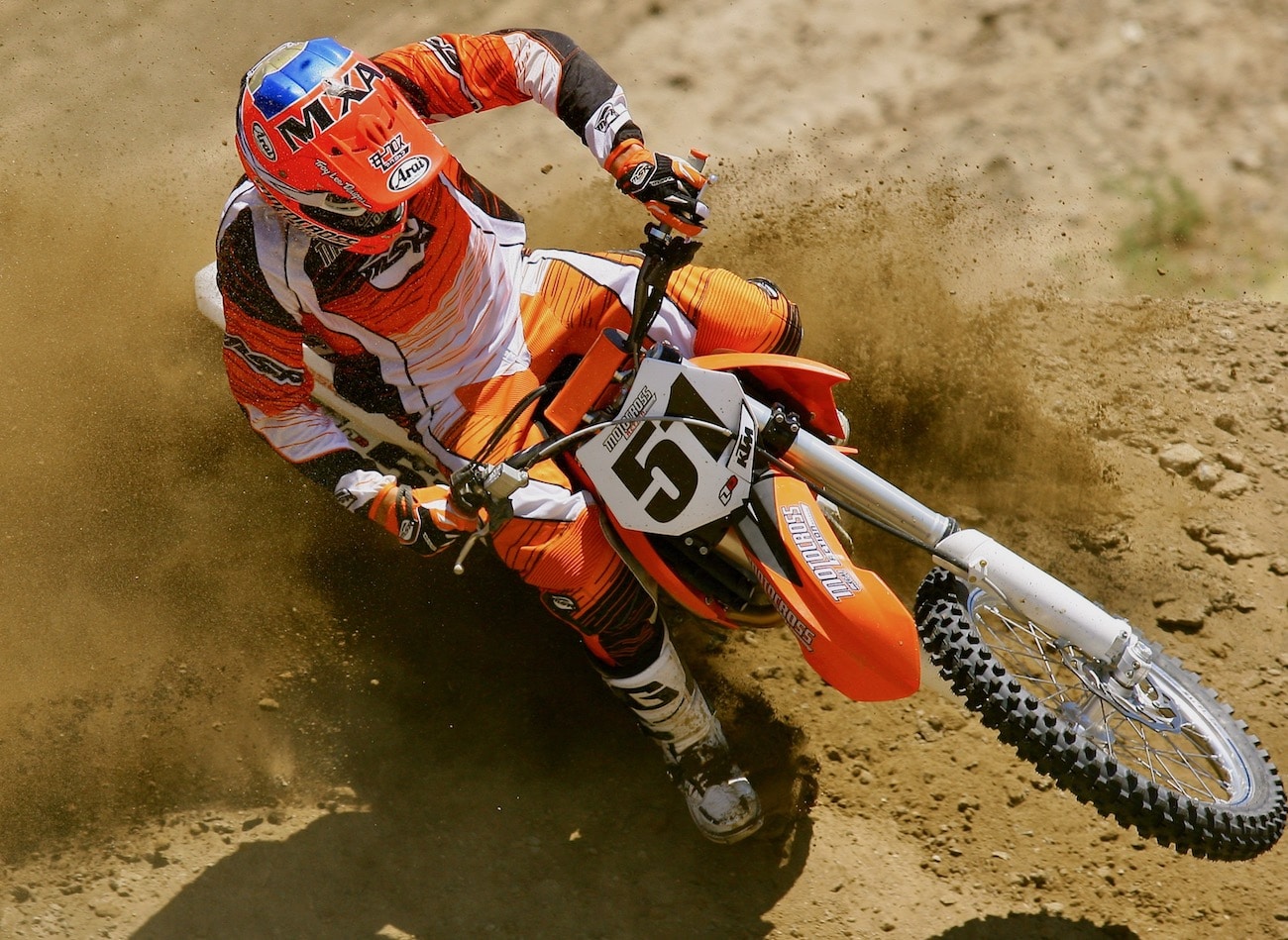






Comments are closed.